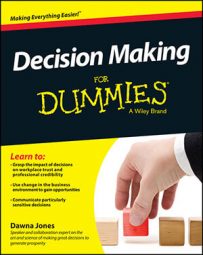Conflict happens. What makes it valuable (or not) is how you use it. Conflict can be used to either accentuate differences or deepen understanding of what makes a person tick. The difference lies in asking the question, “What can you learn from this that adds to shaping a solution, achieving the goal, improving understanding, or promoting growth?”
Unfortunately, the typical approach to conflict asks the question, “How can you win or get your way?” This approach assumes that, in the case of opposing ideas, one person is right and the other is wrong and that the only way you can prevail is if the other person loses.
In addition, the conflicts you have with other people aren’t the only conflicts that can stymy your progress or undermine your success. You can also be in conflict with yourself. When your expectations for what you thought, hoped, or wanted to happen don’t materialize as you planned, you get mad at yourself, feel self-doubt or self-judgment, or blame someone else — and end up expending a lot of energy on being angry.
Conflict can be detrimental. Therefore, it’s important to know what can trigger conflict. Triggers for conflict include the following:
Differences in information and different interpretations of the same information: The same information can be perceived in many different ways. If one person needs his or her interpretation to be the “right” interpretation, conflict can result. A better approach is to collect diverse perspectives to form a more complete picture.
Interpersonal conflict, for example, often results when two opposing views of what happened or what “should have” happened collide. Rather than fighting it out to see whose view wins, ask questions to discover what values or interests lie beneath the two views. This approach often leads to a better solution.
Differences in values due to dissimilar ways of thinking about what’s important: Companies and individuals often use beliefs to make their decisions. Beliefs are about what you think is true about how the world works. Values are about what is important.
When a decision pops up that inspires a conversation about what’s important, you’ve entered into a discussion about what values will hold sway when making the decision. The conflict creeps in when the participants have different values and beliefs about what is relevant and are not able to separate one from the other to gain objective clarity.
Use the difference of opinions creatively to explore what is important to each person and why. Engage in dialogue to find out the other person’s views on the subject. In a business setting, if the company is clear about its values, aligning the decision to the values is a natural step.
Unmet expectations that create feelings of fear or lack of trust: Fixed ideas on what should happen next or what you expect to happen is a surefire way to be disappointed when the outcome doesn’t turn out exactly as you expected. The conflict arises from not trusting that what shows up has value to your life. A better approach is to be open to the outcome rather than trying to control it.
On a personal level, think of relationships that haven’t worked out according to plan. In business, think of projects that went sideways. Analyze the unmet expectations to discover where you can replace fear or lack of trust with more trust in yourself. Discover what you can learn from projects that didn’t turn out as planned.

